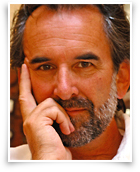
Richard Harvey
connecting psychotherapy and spiritual growth for human awakeningx
Practice in The Way of Sacred Attention: Part 4
Third-stage practice involves living in the fearless conditionless state of non-identification. Fearless—because the conditions of the world that humans tend to project as threatening are no longer present. Conditionless—because the identification and clinging to changing conditions that human beings tend to identify with and use to create a background narrative or context for the invention of their small petty self is no longer convincing. And non-identification—because in the great insight of third-stage awakening the separate self is revealed as a fiction of the ego-processes fuelled by the inventions of the small mind.
Whether originating in the physical/karmic, the emotional/devotional, or the mental/wisdom conditions of spiritual character, the devotee now exhibits devotion in all his or her actions, thoughts, emotions, and energetic vibration. The love of life is superseded by the celebration of life. The plague and unrest of fear and desire now yields to a deep relaxation in peace, tranquility, and equanimity in the face of all relative changes.
What practice can possibly reflect the profundity of all this. The answer is the devotee’s life is a demonstration of all these blessings and more. How he may choose to live comes from a far different place in him than the place of personal preference and individual choice
Everything can be sadhana—all your everyday actions, relating, and behavior. How you sit, walk, stand, eat, speak; how your thoughts, feelings, emotions, and energies manifest—all is a means for living sadhana. Naturally you involve yourself in sacred practices and spiritual exercises, but these sacred-spiritual activities are no different at all to your normal routine everyday functioning, and everything radiates your present illumination.
Subtle holdings of the ego-self, any surrender to personal power or “specialness,” deep karmic struggles, or attraction to self-aggrandizement is worked on with your spiritual teacher in the third stage of awakening. The very deepest aspects of manifestation of negative states (as sometimes fine holdings, often impersonal now) are dissolved in avid practice and the intensity of devotional discipline.
It would be an understatement to say that practice in the third stage is hard, demanding, or difficult. Practice in any and all of the stages is increasingly serious and challenging. The aspirant’s capacity grows accordingly as he deepens in commitment. Yet the apprehension of sadhana, discipline, and practice as difficult and testing is in direct proportion to the illusory presence in the practitioner’s life. The demands of the spiritual path (in the third stage) would be impossible indeed for the first-stage practitioner. The resistance is itself the presence of ego processes, so even as the ego-self is eroded so our ability to engage in sacred spiritual life is made possible by surrender and devotion.
I have prepared two courses, which present third-stage practice in more detail. They are The Sacred Attention Vision and Realizing the Divine. Those of you who perceive a sincere calling to spiritual life should consult the guidance and support in those courses to set out and stabilize in spiritual life.
Prior to engaging in earnest with spiritual sadhana there are pleadings and justifications from the ego-self. Delay, wait for a better (the best!) time, be sensible (!), think it through, distrust, uncertainty, just one more experience you are attached to… the list is endless, is it not? And yet when the aspirant is serious, devoted, and clear that the most important thing to do in this lifetime is to act now to awaken to enlightenment, no real argument exists. You simply fly into the divine embrace.
... flying, running and rejoicing... he is free and will not be bound... —Thomas à Kempis, The Imitation of Christ
The music reached the ears of the Gopis of Vraja. They could not resist its appeal. It went straight to their hearts. It carried an unearthly significance for them. It had the air of the deep calling to the deep. Obeying its powerful call they involuntarily rushed out of their houses throwing aside the house-hold work to take care of itself. It did not even occur to them to find out whether they were properly dressed. They vied with one another in reaching the place as fast as they could. They had yielded their hearts to Sri Krishna and approached him as if he were their illicit lover. —Rasa Kreda, from the commentary of M. K. Venkatarama Iyer
Life is swept along,
next-to-nothing its span.
For one swept to old age
no shelters exist.
Perceiving this danger in death,
one should drop the world's bait
and look for peace.
—Uttara Sutta: Uttara the Deva's Son, trans.Thanissaro Bhikkhu
We must go to where the life is, to where the joyous music is
playing. Existence offers no certainty or security, but letting go,
being flexible, surrendering, we return to the great flow at the border
of timeless space and being: the river has remembered and returned to
the ocean. We have discovered that we really are unconditioned, absolute
Being. We have remembered our Real Self now we have journeyed round our
self in revelation. At last we are undeceived and we have stopped
creating a world and populating it. We know now that there is no journey
to where we already are.
—Richard Harvey, Your
Essential Self, 235
(“Practice in The Way of Sacred Attention” is a four-part article. Parts 1 and 2 gave an introduction and discussed practice in the first stage of awakening. Part 3 discussed practice in the second stage of awakening.)
Share this article
This article was published on this site in 2019.